
Laothoe populi, the poplar hawk-moth, is a moth of the family Sphingidae. The species was first described by Carl Linnaeus in his 1758 10th edition of Systema Naturae. It is found throughout the Palearctic region and the Near East and is one of the most common members of the family in the region. It is distinctive due to its habit of resting with its hindwings held further forward than the forewings.
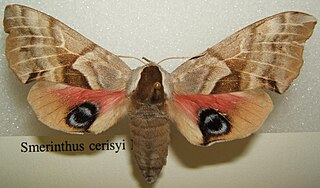
Smerinthus cerisyi, the one-eyed sphinx or Cerisy's sphinx, is a moth of the family Sphingidae. The species was first described by William Kirby who named the species in honor of Alexandre Louis Lefèbvre de Cérisy in 1837. It is known from south-eastern Alaska, the southern parts of all Canadian provinces and in the northern border states of the United States south into northern Indiana, Pennsylvania and Ohio and along the west coast to southern California, eastward to the Rocky Mountains and into western New Mexico north to western North Dakota. It has also been recorded from Illinois and as far south as Missouri.

Pachysphinx modesta, the modest sphinx or poplar sphinx, is a moth of the family Sphingidae. The species was first described by Thaddeus William Harris in 1839.
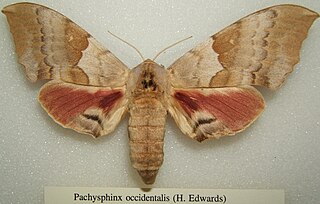
Pachysphinx occidentalis, the big poplar sphinx, is a moth of the family Sphingidae. The species was first described by Henry Edwards in 1875. It lives throughout Canada and the United States. The habitat consists of riparian areas and suburbs.

Hyles hippophaes, the seathorn hawk-moth, is a species of moth in the family Sphingidae. The species was first described by Eugenius Johann Christoph Esper in 1789.

Laothoe amurensis, the aspen hawk-moth, is a moth of the family Sphingidae.
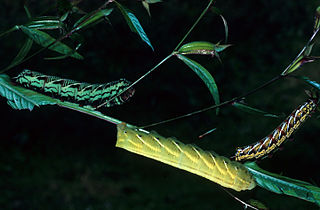
Proserpinus juanita, the Juanita sphinx, is a moth of the family Sphingidae first described by Herman Strecker in 1877. It is found from the US state of North Dakota south to Arizona and east to Missouri and Texas.
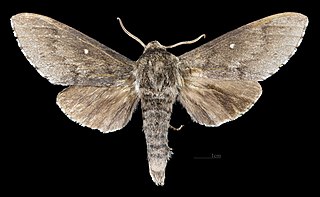
Sphingulus is a genus of moths in the family Sphingidae, containing only one species, Sphingulus mus, the murine hawkmoth.

Laothoe is a genus of moths in the family Sphingidae first distinguished by Johan Christian Fabricius in 1807.
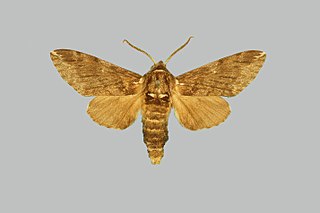
Dolbina elegans, the ash hawkmoth, is a moth of the family Sphingidae. The species was first described by Andreas Bang-Haas in 1912. It is found from Ukraine, Moldavia, through eastern Romania and eastern and southern Bulgaria, northern Greece, western and southern Turkey to northern Syria, western Jordan, Israel, northern Iraq and northern Iran.
Laothoe habeli is a moth of the family Sphingidae found in China. In Shaanxi, it is found on altitudes between 1,500 and 1,900 meters; in Sichuan it is found up to 2,400 meters.

Hyles centralasiae, the eastern foxtail-lily hawkmoth, is a moth of the family Sphingidae. The species was first described by Otto Staudinger in 1887. It is found from eastern Turkey and Armenia east across northern Iraq, northern Iran, southern Turkmenistan, the mountainous areas of eastern Uzbekistan and southern Kazakhstan to Tajikistan, Kyrgyzstan, Afghanistan and northern Xinjiang in China.
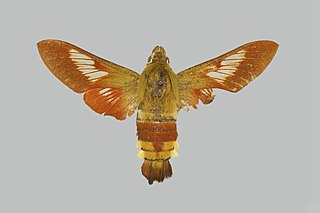
Hemaris dentata, the Anatolian bee hawkmoth, is a moth of the family Sphingidae. The species was first described by Otto Staudinger in 1887. It is known from southern Turkey as far west as the Taurus Mountains.

Laothoe populeti is a species of moth of the family Sphingidae. It is found from eastern Turkey and Armenia, through north-eastern Iraq, the Iranian plateau and the central Asian republics of Turkmenistan, Uzbekistan, Tajikistan, Kyrgyzstan, Kazakhstan and north-western China.
Laothoe populetorum is a species of moth of the family Sphingidae. It is found in Kyrgyzstan. It is mostly treated as a variety or form of Laothoe populi.
Laothoe philerema, the Pamir poplar hawkmoth, is a moth of the family Sphingidae. The species was first described by Alexander Michailovitsch Djakonov in 1923. It is known from eastern Turkmenistan, southern Uzbekistan, Tajikistan and eastern Afghanistan.

Dolbina exacta, the exact grizzled hawkmoth, is a species of moth of the family Sphingidae. It is found from the southern part of the Russian Far East, Japan and the Korean Peninsula, south into China as far as Sichuan, Hubei and Zhejiang. The habitat consists of open parklands and forest edges.

Dolbina tancrei is a species of moth of the family Sphingidae. It is known from the Russian Far East, north-eastern China, the Korean Peninsula and Japan.

Kentrochrysalis streckeri is a species of moth of the family Sphingidae. It is known from Mongolia, the Russian Far East, north-eastern China and North Korea.

Ambulyx staudingeri is a species of moth of the family Sphingidae first described by Walter Rothschild in 1894. It is known from the Philippines.
















